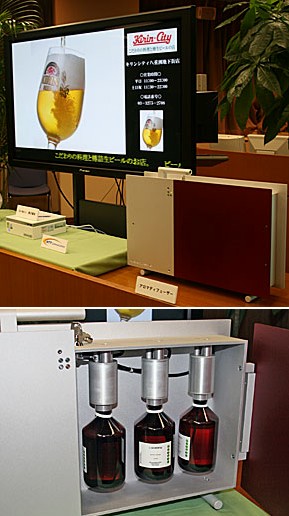 NTT Communications (NTT Com) has announced plans to begin testing its latest aroma-emitting digital sign technology, called "Kaoru Digital Signage," in Tokyo. The tests, which will take place outside the Kirin City Beer Hall in the underground Yaesu Shopping Mall (JR Tokyo station) from October 21 to the end of December, will involve internet-controlled signs that display electronic imagery of beer while emitting aromas such as lemon and orange. The researchers aim to study the sign's effectiveness in drawing passersby into the restaurant.
NTT Communications (NTT Com) has announced plans to begin testing its latest aroma-emitting digital sign technology, called "Kaoru Digital Signage," in Tokyo. The tests, which will take place outside the Kirin City Beer Hall in the underground Yaesu Shopping Mall (JR Tokyo station) from October 21 to the end of December, will involve internet-controlled signs that display electronic imagery of beer while emitting aromas such as lemon and orange. The researchers aim to study the sign's effectiveness in drawing passersby into the restaurant.
Billed as the world's first advertising sign system capable of emitting multiple aromas while displaying electronic images, the signs combine NTT's Spot Media digital signage service (currently used in marketing and customer service applications at banks, hospitals, public offices and retail stores) with its Kaori Tsushin online fragrance communication service. Kaori Tsushin, which gives users web-based control over aroma-emitting devices, is already in use at retail stores and cafes, where it is reportedly helping to improve on-site customer satisfaction.
NTT's new sign system consists of a 30 x 50 x 15 centimeter (12 x 20 x 6 inch) aroma diffuser, a 19-inch display and an NTT Spot Media content receiver, which are used to deliver aroma and display images of beer (and live shots from inside the restaurant) based on instructions received via a web connection. In the tests, the sign's smell will change according to the time of day, dispersing appetizing orange and lemon aromas at lunchtime, and releasing a more relaxing "woody" aroma at night.
The aroma diffuser contains three 450-milliliter bottles of aroma oil. When the "recipe" -- which determines the type and strength of smell -- is received via the web, the device releases a vapor created by blasting the oil with a series of ultrasonic waves. With the ability to deliver fragrances across a 500 square meter (5,400 square feet) area, the new aroma diffuser is a great deal more powerful than NTT's Aromageur, which was developed for personal use in spaces the size of a small bedroom.
The scheduled testing follows a spate of aroma-related experiments conducted by NTT earlier this year. On Valentine's Day, NTT researchers conducted an experiment with vanilla fragrance in an office lobby. When vanilla fragrance was periodically released near free chocolate (labeled with a "Please Take One" sign) placed on a reception counter, the researchers found that passersby were nearly twice as likely to take a chocolate. In other experiments conducted at Tokyo-area bookstores from May to September, relaxing orange and lavender aromas were found to boost monthly sales by nearly 5%.
[Sources: NTT press release, IT Media]







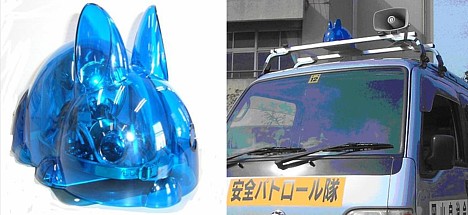
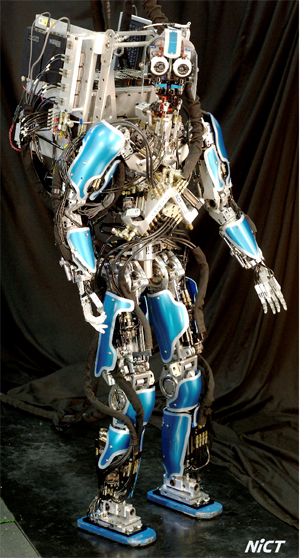 As Japan's population continues to age and shrink, more and more people are looking at robots as a way to improve productivity and support the nation's changing lifestyles. With human-robot interactions on the rise, and with the recognition that much of human communication is nonverbal, researchers at Japan's National Institute of Information and Communications Technology (
As Japan's population continues to age and shrink, more and more people are looking at robots as a way to improve productivity and support the nation's changing lifestyles. With human-robot interactions on the rise, and with the recognition that much of human communication is nonverbal, researchers at Japan's National Institute of Information and Communications Technology (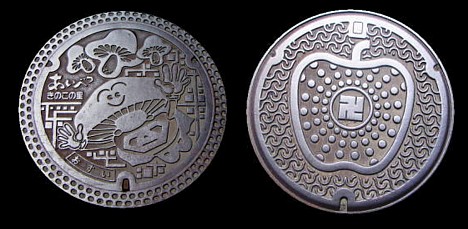









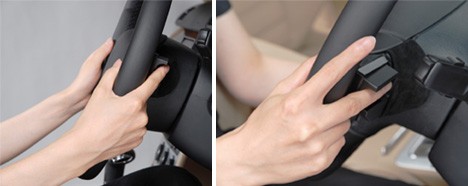


 NTT Communications (NTT Com) has announced plans to begin testing its latest aroma-emitting digital sign technology, called "Kaoru Digital Signage," in Tokyo. The tests, which will take place outside the Kirin City Beer Hall in the underground Yaesu Shopping Mall (JR Tokyo station) from October 21 to the end of December, will involve internet-controlled signs that display electronic imagery of beer while emitting aromas such as lemon and orange. The researchers aim to study the sign's effectiveness in drawing passersby into the restaurant.
NTT Communications (NTT Com) has announced plans to begin testing its latest aroma-emitting digital sign technology, called "Kaoru Digital Signage," in Tokyo. The tests, which will take place outside the Kirin City Beer Hall in the underground Yaesu Shopping Mall (JR Tokyo station) from October 21 to the end of December, will involve internet-controlled signs that display electronic imagery of beer while emitting aromas such as lemon and orange. The researchers aim to study the sign's effectiveness in drawing passersby into the restaurant. 